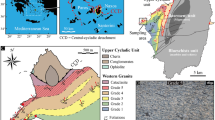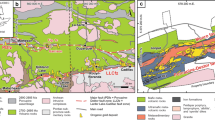Abstract
An understanding of the nature and origin of porosity in sandstones is crucial to the evaluation of their potential as hydrocarbon reservoirs. Primary porosity is normally destroyed by cementation, compaction and pressure solution during burial, but it has recently been recognized that significant secondary porosity can develop at depth1–3. This discovery has been called “the most significant advance in the study of clastic diagenesis in the past decade”4. Several genetic types of secondary porosity have been identified ; these include porosity formed by: (1) fracturing; (2) shrinkage; (3) dissolution of sedimentary grains and matrix; (4) dissolution of authigenic cements; and (5) dissolution of authigenic replacive minerals5. Formation of secondary porosity by framework grain dissolution has been thought mainly to involve decomposition of feldspars and lithic grains6,7.We demonstrate here that significant secondary porosity can also develop by dissolution of quartz framework grains if the rocks are exposed to alkaline pore fluids during deep burial and/or uplift.
This is a preview of subscription content, access via your institution
Access options
Subscribe to this journal
Receive 51 print issues and online access
$199.00 per year
only $3.90 per issue
Buy this article
- Purchase on Springer Link
- Instant access to full article PDF
Prices may be subject to local taxes which are calculated during checkout
Similar content being viewed by others
References
Hayes, J. B. Soc. Econ. Paleont. Miner. Spec. Publ. 26, 127–139 (1979).
Schmidt, V. & McDonald, D. A. Soc. Econ. Paleoni. Miner. Spec. Publ. 26, 175–207 (1979).
Siebert, R. M., Moncure, G. K. & Lahann, R. W. Am. Ass. petrol. Geol. Mem. 37, 163–176 (1984).
Surdam, R. C., Boese, S. W. & Crossey, L. J. Am. Ass. petrol. Geol. Mem. 37, 127–149 (1984).
Schmidt, V. & McDonald, D. A. Soc. Econ. Paleoni. Miner. Spec. Publ. 26, 209–225 (1979).
Curtis, C. D. Geol. Soc. Lond. Spec. Publ. 12, 113–125 (1984).
Lundegard, P. D., Land, L. S. & Galloway, W. E. Geology 12, 399–402 (1984).
Glennie, K. W., Mudd, G. C. & Nagtegaal, P. J. C. J. geol. Soc. Lond. 135, 25–34 (1978).
Nagtegaal, P. J. C. J. petrol. Geol. 2, 145–158 (1979).
Rossel, N. C. Clay Miner. 17, 69–78 (1982).
Pye, K. & Krinsley, D. H. Clay Miner. (in the press).
Blatt, H. & Christie, J. M. J. sedim. Petrol. 33, 559–579 (1963).
Blatt, H. J. sedim. Petrol. 37, 401–424 (1967).
Little, I. P., Armitage, T. M. & Gilkes, R. J. Geoderma 20, 225–237 (1978).
Pye, K. Sedim. Geol. 34, 267–182 (1983).
Siever, R. J. Geol. 70, 127–150 (1962).
Krauskopf, K. B. Introduction to Geochemistry, 2nd edn (McGraw-Hill, New York, 1979).
Fuchtbauer, H. Geol. Rdsch. 68, 1125–1151 (1979).
Author information
Authors and Affiliations
Rights and permissions
About this article
Cite this article
Pye, K., Krinsley, D. Formation of secondary porosity in sandstones by quartz framework grain dissolution. Nature 317, 54–56 (1985). https://doi.org/10.1038/317054a0
Received:
Accepted:
Issue Date:
DOI: https://doi.org/10.1038/317054a0
This article is cited by
Comments
By submitting a comment you agree to abide by our Terms and Community Guidelines. If you find something abusive or that does not comply with our terms or guidelines please flag it as inappropriate.



